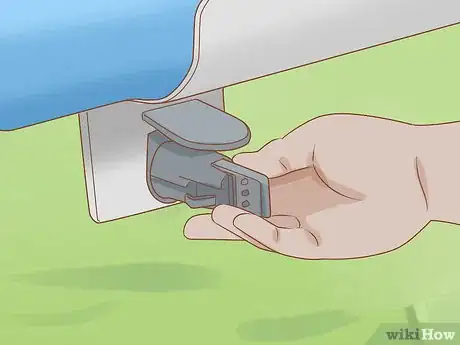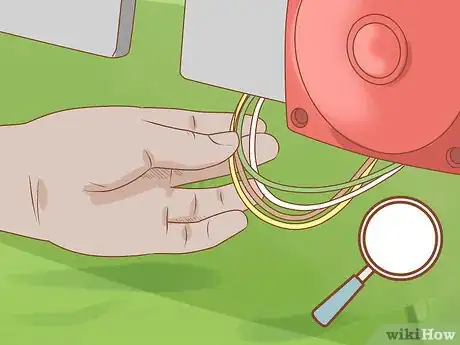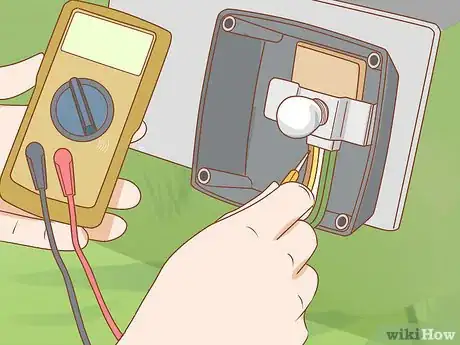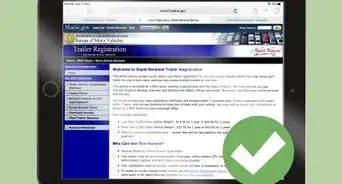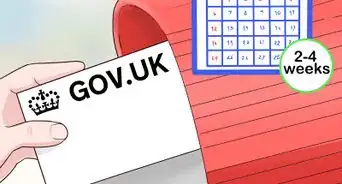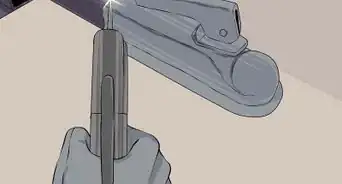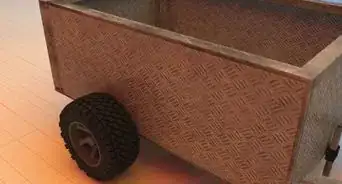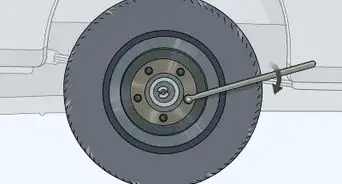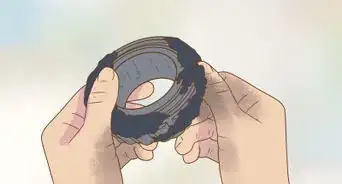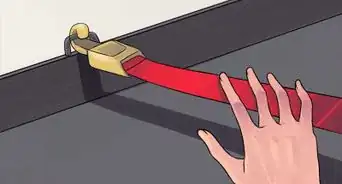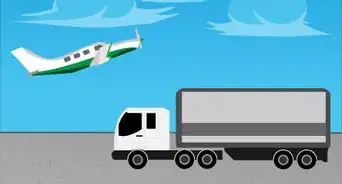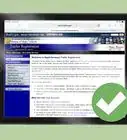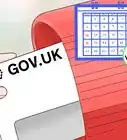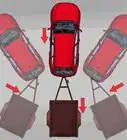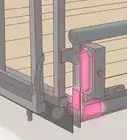This article was co-authored by wikiHow Staff. Our trained team of editors and researchers validate articles for accuracy and comprehensiveness. wikiHow's Content Management Team carefully monitors the work from our editorial staff to ensure that each article is backed by trusted research and meets our high quality standards.
There are 8 references cited in this article, which can be found at the bottom of the page.
This article has been viewed 53,972 times.
Learn more...
It's important that your trailer lights are in proper working condition so that other drivers will see you signal and brake. If your trailer lights seem to be malfunctioning, you can test them in several ways to possibly diagnose and fix the problem yourself. First, you'll want to do a simple test with someone else to verify that they are working. If they aren't, you can use tools like a tow-vehicle light tester and multimeter to see if the wires and contacts within your trailer's circuitry are broken.
Steps
Diagnosing the Problem
-
1Test the lights while someone observes if they are working. Start up the tow vehicle or truck with the trailer attached to it. Ensure that the wire to the trailer is plugged into the connector on the back of your vehicle. Press the brake, hazard lights, and both blinker lights while someone stands behind the trailer to see if all the lights are working properly. The lights on the trailer should correspond with the lights on the back of the tow vehicle.[1]
- If some lights don't turn on or are dim, take note of which ones are malfunctioning.
-
2Replace the lightbulb if only one light isn’t working. If one light doesn’t turn on, it’s possible that the bulb has blown out. Use a screwdriver to remove the screws in each corner of the faceplate over the light on the trailer. Unscrew the blown bulb and replace it with one of the same voltage. Test the lights again by pressing on the brakes in your tow vehicle.[2]
- If the light still doesn’t come on, you know there is a problem with the wiring.
Advertisement -
3Disconnect the tow vehicle from the trailer. Remove the chains connecting the trailer to the tow vehicle and lift up the latch on the front of the trailer. Turn the crank on the front of the trailer clockwise to lift the trailer up, then push the trailer away from the tow vehicle. Unplug the black trailer cord from the tow vehicle so that you can test all the connections individually.[3]
- Ensure that the front wheel is engaged on the front of the trailer when disconnecting it or it could tip forward.
- It’s important to completely disconnect the trailer from the tow vehicle so that you’re not concealing any problems with the ground wire.
-
4Plug a tow-vehicle light tester into your vehicle’s connector. Line up the teeth on the light tester with the plug near the back bumper of your tow vehicle and push the tester into the vehicle's connector. If the tester light turns red or yellow, you know that there’s a problem with your vehicle’s connector and not the trailer lights. In this case, make sure you don’t have a blown fuse by checking that all of your tow vehicle lights are actually working.[4]
- You can buy a tow-vehicle tester light online for around €9.
- Wipe down the contacts on the connector with contact cleaner and a rag to solve any potential problems with the plug.
- If you can’t troubleshoot the problem yourself, you may have to take it to professionals so that they can check your truck’s wiring.
-
5Look for broken wires connecting to your trailer lights. Some of the wires may be obscured because they run into the frame of the trailer. If you don’t see any visible damage to the wires and suspect that the wires inside of the frame might be broken or frayed, you'll need to take the trailer to a professional for repairs.[5]
- The white wire is the trailer’s ground wire.
- The brown wire is for your tail lights.
- The green wire is for your right turn signal and right brake light.
- The yellow wire operates your left turn signal and left brake light.
Testing for Continuity with a Multimeter
-
1Clip the multimeter to the green contact on the trailer cord. Set the multimeter to continuity mode. You can find what the icon for continuity looks like in your multimeter user manual. Take the red wire from the multimeter and clip it to the contact connected to the green wire inside of the plug in the connector for the trailer.[6]
- Make sure that your wires are long enough so that you can still reach the back of the trailer.
-
2Unscrew the cap to a light that doesn’t work. If the cap to the light is still on, you’ll need to remove it to access the wire contacts in the light. Use a screwdriver to remove the screws in each corner of the cap. Then, pop the cap off to reveal the light bulb and wire contacts under it.[7]
- Set the cap aside in a safe place so that you can reattach it later.
-
3Touch the green contact under the light with the multimeter. Touch the other wire on your multimeter with the contact under the light to test for continuity. The continuity on your trailer wire should be close to .6 or .7 ohms. If there is no reading when you touch the black wire to the trailer contact, you know that the specific wire running to that contact is malfunctioning or broken.[8]
- A professional will be able to rewire lights for you.
-
4Unclip the multimeter and repeat the process on the other wires. To test the other wires, detach the multimeter from the green contact in the trailer plug, and reattach it to whatever contact you want to test. Then, touch the black wire on the multimeter with the same colored contact under the light at the back of the trailer. Continue testing each wire for continuity until you find one that doesn’t work.[9]
- If all the wires seem to be working, then you may have to clean or fix the contacts on the plug, or there may be a problem with your tow vehicle circuitry.
Cleaning and Fixing the Wire Contacts
-
1Sand the contacts on the trailer wire and vehicle’s connector. Lightly scrape the contacts on the end of the trailer wire with 100-150 grit sandpaper to remove any buildup that may be blocking the connection. Repeat the process on the contacts on the vehicle’s connector.[10]
- This process should only take 10-30 seconds.
- Do not scrape the contacts too hard or you could damage them.
-
2Spray the trailer wire contacts with contact cleaner and apply grease. Spray the can of contact cleaner directly on the contacts in the plug and the trailer lights to remove any dirt and debris that could be interfering with the connection. Then, apply a good amount of dielectric grease to the contacts on the trailer plug and the trailer lights to improve the connection.[11]
- Cleaning and greasing the contacts could resolve dimming issues you may have with your lights.
-
3Plug the trailer into your tow vehicle and test the lights. Lower the trailer back onto the tow vehicle and plug the wire back into the vehicle’s connector. Turn the truck on and test the lights. If the lights still don’t work, you may have to take it to a professional to diagnose potential issues with the circuitry or wiring in the trailer.[12]
- Being able to diagnose what the potential problems are could help in making speedy repairs to the trailer.
References
- ↑ https://www.familyhandyman.com/automotive/utility-trailer/fix-bad-boat-and-utility-trailer-wiring/view-all/
- ↑ https://youtu.be/dFb-bVXbq9w?t=1m20s
- ↑ https://youtu.be/dFb-bVXbq9w?t=12s
- ↑ https://youtu.be/dFb-bVXbq9w?t=16s
- ↑ https://www.familyhandyman.com/automotive/utility-trailer/fix-bad-boat-and-utility-trailer-wiring/view-all/
- ↑ https://youtu.be/dFb-bVXbq9w?t=2m4s
- ↑ https://www.familyhandyman.com/automotive/utility-trailer/fix-bad-boat-and-utility-trailer-wiring/view-all/
- ↑ https://youtu.be/dFb-bVXbq9w?t=2m7s
- ↑ https://youtu.be/dFb-bVXbq9w?t=2m7s
About This Article
To test your trailer lights, first have someone stand behind the trailer so they can see the rear lights. Then, press the brake, hazard lights, and both blinkers to check that they work. If you don’t have someone with you, try using a tow-vehicle tester, which you can buy online relatively cheaply. Once you have your tester, line up the teeth with the plug near the back bumper of your tow vehicle and push the tester into the vehicle’s connector. If the tester light turns red or yellow, it means that there’s a problem with your vehicle’s connector and not with the trailer lights. To learn how to test for continuity with a multimeter, read on!



